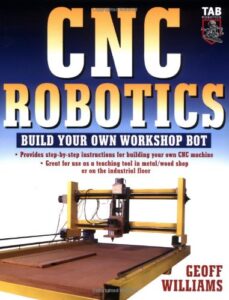| Book Name: | CNC Robotics Build Your Own Workshop Bot by Geoff Williams |
| Category: | Robotics |
| Language: | English |
| Format: | |
| Free Download: | Available |
CNC Robotics Build Your Own Workshop Bot by Geoff Williams | PDF Free Download.
| Book Details : | |
|---|---|
| Language | English |
| Pages | 321 |
| Format | |
| Size | 55.8 MB |
CNC Robotics Build Your Own Workshop Bot by Geoff Williams
Book Description:
Heres the FIRST book to offer step-by-step guidelines that walk the reader through the entire process a building a CNC (Computer Numerical Control) machine from start to finish. Using inexpensive, off-the-shelf parts, readers can build CNC machines with true industrial shop applications such as machining, routing, and cutting–at a fraction of what it would cost to purchase one.
– Great for anyone who wants to automate a task in their home shop or small business
– Easy-to-use Windows-based software controls the robotic automation
– Builders can scale and customize the machine to suit their own industrial needs
– Numerous tips, tricks, and pictorials walk the reader through every step–design, construction, and completion

CNC Robotics Contents
Design
- Why Build My Own
- Gantry Style
- Motors
- Linear Motion
- Motor Drivers
- Acme Screw
- Deciding on the Dimensions of the Machin
- Software
Electronics
- Stepper Motor Driver and Computer Interface Boards
- Stepper Motor Driver Circuit
- The Interface Board
Making the Printed Circuit Board
- Tools and Material
- Artwork
- Board Cutting and Cleaning
- Toner Transfer
- Etching
Driver Assembly
- The Interface Board
Software Setup and Driver Testing
- Material Needed
- Creat ing Test Files
- Triangle Test
- Circle Test
- Putting the Electronics in a Case
The Frame
- Tools and Material
- Bolting
- Assemb ly
- Bearing Rail Support Bolt Holes
- Paint the Frame
The Gantry and X-axis
- The Gantry
- The X-axis: Installing the Gantry Bearing Guide Rail
- Beari ng Holder
The Z and Y Axes
- The Z-Axis
- The Y-Axls
Motor and Lead Screw Installation
- Tools and Material
- X-axis
- Y-axls
- Z-axis
- Limit Switch Installation
- X-axis Limits
- Y-axis Limits
- Z-axis Limits
File Creation and KCam
- KCam CNC Controller Software
- KCam File Requirements
- How to Create a File to Import
- CorelDraw
- ACME Profiler
Tool Holders and Testing
- Tool Holders
- Penholder Tool
- Router/Dremel Holder
- Testing the CNC Machine
Examples
- Plotter
- Mechanical Engraving Tool
- Dremel Tool
- Master Craft Rotary Tool
- Router
CNC Robotics
CNC Robotics is a powerful tool to have in any workshop. It is a computer-controlled machine that uses various tools such as drills, saws, and routers to create precise cuts and shapes. The machine’s movements are controlled by a computer program, which means that once the design has been inputted into the system, it can produce numerous identical pieces with minimal human intervention.
Building your own CNC robot can be an exciting project for any DIY enthusiast. With the right components and software knowledge, you can assemble your own workshop bot that will help you increase productivity while minimizing errors. Whether you’re interested in creating intricate designs or producing large batches of parts with high accuracy and repeatability, CNC robotics is an excellent choice.
There are various types of CNC robots available on the market today. Some machines are designed for smaller projects like engraving or cutting soft materials such as wood or foam board, while others are more robust and ideal for larger-scale projects like metalworking or automotive repair work. Assembling your own CNC robot allows you to tailor it to suit your specific needs and budget constraints while providing a great sense of accomplishment when completed successfully. see also G code and M Code for CNC.
What is CNC?
CNC stands for Computer Numerical Control. It is a system that uses computers to control machine tools and other manufacturing processes. CNC machines are used in many industries, including aerospace, automotive, medical equipment, and woodworking.
CNC machines use digital instructions to control the movements of the cutting tool or other tooling on the machine. The instructions are sent to the machine through software programs that allow users to design and program parts or products. Once programmed, CNC machines can produce precise parts with high accuracy and repeatability.
CNC robotics is a type of CNC technology that uses robots to automate manufacturing processes. These robots can be programmed to perform a variety of tasks, such as welding, painting, or assembly. By using robotics in combination with CNC technology, manufacturers can increase efficiency and reduce labor costs while maintaining high levels of precision and quality assurance. Building your own workshop bot can be a fun DIY project for makers interested in exploring this exciting field of automation technology.
Benefits of Owning a Robot
Owning a robot can bring numerous benefits to your workshop, especially when it comes to CNC robotics. With a robot, you can automate many of the labor-intensive tasks that would otherwise require human intervention. This means you can produce parts more quickly and efficiently than with manual labor alone, freeing up time for other critical tasks. Additionally, robots are often capable of working 24/7 without needing breaks or rest, increasing productivity even further.
Another advantage of owning a robot is increased precision and accuracy in machining parts. Robots are programmable and have the ability to repeat precise movements with extreme accuracy every time they perform a task. This consistency ensures quality control and reduces the likelihood of errors or defects in your finished products.
Finally, owning a robot can improve worker safety by reducing risk factors associated with certain manual labor tasks. By automating these processes with robots, workers can avoid exposure to potential hazards such as sharp edges, heavy lifting or repetitive motions that may cause injuries over time. Overall, incorporating robotics into your workshop offers significant benefits that directly impact efficiency and safety while also providing long-term value through increased productivity and quality output.
Building Your Own Workshop Bot
CNC (Computer Numerical Control) robotics has taken the manufacturing industry by storm over the past few years. These machines use advanced technology and software to automate complex tasks, delivering precision and accuracy like never before. However, these machines can also be quite expensive, making them out of reach for many hobbyists and small businesses.
That’s where building your own workshop bot comes in. With a little bit of technical know-how and some determination, it is possible to create your CNC robot at a fraction of the cost of buying one commercially. Building your own workshop bot allows you to customize it according to your specific needs – whether that’s engraving intricate designs or cutting through tough materials like metal or wood.
When building your workshop bot, there are several factors to consider such as choosing the right motors and control systems, designing CAD files, selecting suitable materials for construction among other things. It’s important to do thorough research before starting on this endeavor but with some patience and hard work come rewards that are worth every penny!
Design Considerations
When building your own CNC robotics workshop bot, there are several design considerations that you need to keep in mind. One of the most important factors is the type of material that you will use for the frame and body of the robot. The material should be strong enough to support all the components without adding unnecessary weight or bulk. Aluminum is a popular choice due to its strength and lightweight, which makes it easy to maneuver.
Another important design consideration is the size of your robot. You need to determine how big or small you want your robot to be based on the tasks you want it to perform. A larger bot may have more stability and can handle heavier loads, but it may not be as flexible as a smaller one when moving around tight spaces.
Lastly, it’s essential to consider your power source when designing your CNC robotics workshop bot. The power supply should provide enough energy for all equipment components while also being easily accessible and manageable within your workspace. Additionally, consider using rechargeable batteries or solar panels so that your robot can operate continuously without interruption while saving on energy costs in the long run.
Parts & Materials Needed
When it comes to building your own CNC robotics workshop bot, there are several parts and materials that you will need in order to make sure everything runs smoothly. One of the most important pieces is the actual CNC machine itself, which can be purchased pre-made or built from scratch using various components such as stepper motors, linear rails, and a control board. Additionally, you may need tools like wrenches and screwdrivers to assemble everything together.
Another essential element for your workshop bot is the computer software needed to operate it effectively. This includes CAD software for designing your models as well as CAM software for generating tool paths that the robot will follow during machining. You’ll also need some basic electrical components like wires, connectors, and switches to connect all of these systems together properly.
Finally, it’s important not to overlook things like safety gear when building a workshop bot. This includes things like gloves and eye protection while handling metalworking tools or chemicals used during the build process. By taking these steps and ensuring that you have all of the necessary parts and materials before starting your build, you can help guarantee success in constructing an effective CNC robotics workshop bot that meets all of your needs.
Step by Step Guide
1. The first step in building your own CNC robotics workshop bot involves identifying the purpose and function of the machine. This will help you determine the necessary size, power requirements, and tooling options for your bot.
2. Once you have a clear understanding of what you want to achieve with your bot, it’s time to start designing it. You can use CAD software or even sketch out your ideas on paper to create a blueprint that includes all necessary components and dimensions.
3. After designing your bot, it’s time to gather all the materials and tools needed for construction. This includes everything from metal sheets and bolts to motors and drivers.
4. With all necessary components in hand, begin assembling your machine according to your blueprint design. Make sure each piece is securely attached before moving on to the next step.
5. Next comes wiring and programming – this is where things get technical! It’s important to follow instructions carefully when connecting electronics such as motors, sensors, and controls.
6. Finally, test out your new creation! Run some trial programs to ensure everything is working as intended before putting it into full production mode.
Whether you’re building a workshop bot for personal projects or commercial use, following these steps will take you through the process from conception to fully functional machinery – ready for whatever tasks come its way!
Conclusion
In conclusion, building your own CNC robot workshop can be a challenging but rewarding experience. With the right tools and resources, you can create a machine that meets your exact specifications and helps you achieve your production goals. However, it’s important to keep in mind that this project requires significant time and effort. You’ll need to invest in quality components and take the time to familiarize yourself with the software needed to control your machine.
One of the biggest advantages of building your own CNC robot is that it allows you to customize every aspect of the machine. This means you can design a device that is optimized for specific tasks or materials, which can significantly improve efficiency and reduce waste. Additionally, because you’re building the machine from scratch, you have complete control over its maintenance and repair needs.
Another benefit of creating your own CNC robot is that it gives you valuable skills that can be applied in other areas of manufacturing or engineering. By learning how to design and build complex automated systems, you’ll develop technical knowledge and problem-solving abilities that will serve you well throughout your career. So if you’re up for the challenge, building a CNC robot workshop could be an excellent investment in both your personal growth and professional development.
Download CNC Robotics: Build Your Own Workshop Bot PDF
Author(s): Geoff Williams
Publisher: McGraw-Hill/TAB Electronics, Year: 2003
ISBN: 9780071418287
Download CNC Robotics Build Your Own Workshop Bot by Geoff Williams in PDF Format For Free.









![[PDF] Draw Buildings and Cities in 15 Minutes Draw Buildings and Cities in 15 Minutes pdf](https://www.freepdfbook.com/wp-content/uploads/2021/06/Draw-Buildings-and-Cities-in-15-Minutes-218x150.jpg)








![[PDF] Digital Image Processing An Algorithmic Introduction Using Java Digital Image Processing An Algorithmic Introduction Using Java](https://www.freepdfbook.com/wp-content/uploads/2022/06/Digital-Image-Processing-An-Algorithmic-Introduction-Using-Java.jpg)




![[PDF] 43 Years JEE ADVANCED + JEE MAIN Chapterwise & Topicwise Solved Papers 43 Years JEE ADVANCED (1978-2020) + JEE MAIN Chapterwise & Topicwise Solved Papers Physics PDF](https://www.freepdfbook.com/wp-content/uploads/2022/03/43-Years-JEE-ADVANCED-1978-2020.jpg)

![[PDF] Problems in Physical Chemistry for JEE (Main & Advanced) Problems in Physical Chemistry for JEE (Main & Advanced) Free PDF Book Download](https://www.freepdfbook.com/wp-content/uploads/2022/03/Problems-in-Physical-Chemistry-for-JEE-Main-Advanced.jpg)
![[PDF] Engineering Physics (McGraw Hill)](https://www.freepdfbook.com/wp-content/uploads/2021/05/bafc8c2685bb6823a9c56134f7fba5df.jpeg)

![[PDF] Engineering Chemistry By Shashi Chawla](https://www.freepdfbook.com/wp-content/uploads/2022/05/Theory-And-Practicals-of-Engineering-Chemistry-By-Shashi-Chawla-free-pdf-book.jpeg)
![[PDF] Chemistry: An Introduction to Organic, Inorganic & Physical Chemistry Chemistry: An Introduction to Organic, Inorganic & Physical Chemistry](https://www.freepdfbook.com/wp-content/uploads/2022/04/Chemistry-An-Introduction-to-Organic-Inorganic-Physical-Chemistry.jpg)
![[PDF] Essentials of Physical Chemistry Essentials of Physical Chemistry Free PDF Book by Bahl](https://www.freepdfbook.com/wp-content/uploads/2022/04/Essentials-of-Physical-Chemistry-bahl.jpg)
![[PDF] Biological control of plant-parasitic nematodes: soil ecosystem management in sustainable agriculture Biological control of plant-parasitic nematodes: soil ecosystem management in sustainable agriculture](https://www.freepdfbook.com/wp-content/uploads/2022/05/Biological-control-of-plant-parasitic-nematodes-soil-ecosystem-management-in-sustainable-agriculture.jpg)
![[PDF] Human Anatomy: Color Atlas and Textbook Human Anatomy: Color Atlas and Textbook Free PDF Book](https://www.freepdfbook.com/wp-content/uploads/2022/05/Human-Anatomy-Color-Atlas-and-Textbook.jpg)
![[PDF] Concepts of Biology Book [Free Download]](https://www.freepdfbook.com/wp-content/uploads/2022/05/Concepts-of-Biology.jpg)
![[PDF] Essentials of Biology [Free Download] Essentials of Biology Free PDF BOok Download](https://www.freepdfbook.com/wp-content/uploads/2022/05/Essentials-of-Biology-Free-PDF-Book-Downlaod.jpg)
![[PDF] Human Biology Book [Free Download]](https://www.freepdfbook.com/wp-content/uploads/2022/05/PDF-Human-Biology-Book-Free-Download.jpg)


